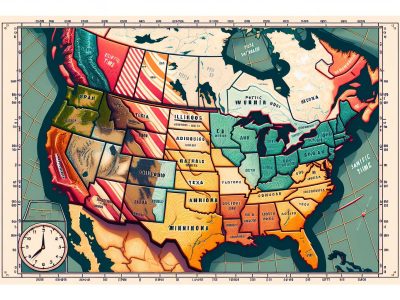Difference Between Central Time and Pacific Time: Key Facts, Tips, and Scheduling Guide
Picture standing on a bustling city street as the golden afternoon sun warms your face—while across the country someone else is just starting their day with a cool morning breeze. Time zones shape your daily rhythm in ways you might not even notice. Central Time and Pacific Time, separated by two hours yet connected by the pulse of the nation, quietly influence everything from business meetings to your favorite TV shows. how a simple shift in the clock can impact productivity, travel, or even your social life? Understanding the difference between Central and Pacific Time isn’t just about numbers on a clock—it’s a key that unlocks smoother communication, smarter planning, and unexpected advantages for work and play. Get ready to discover how mastering these time zones can give you an edge in a world that never sleeps.
Understanding Time Zones in the United States
Ever wonder why a conference call leaves you waiting, but your colleague in California logs in right on time? Time zones like Central Time (CT) and Pacific Time (PT) form the invisible web that tie together activities across states. You live in Houston and want to catch a live NBA match—scheduled for 7 PM Pacific Time. That means you’ll need to tune in at 9 PM Central Time, a detail that’s tripped up even seasoned sports fans.
The US houses six primary time zones: Eastern, Central, Mountain, Pacific, Alaska, and Hawaii-Aleutian. Each one marches to it’s own clock, shifting schedules for over 330 million people. Let’s say, you’re booking a flight from Dallas to San Francisco; flight boards at 1 PM Central, lands at 2:30 PM Pacific, thanks to the time shift, not magic. Miss the detail and you might see your plans unravel quicker than a dropped call on a cross-country drive.
Businesses dance with the reality of these zones every day. Major corporations like Amazon and Microsoft hold daily meetings, lining up calendars in Seattle (PT) and Chicago (CT). Scheduling that doesn’t account for zone conversion stands to lose real dollars—Bloomberg cites scheduling confusion as a leading cause for missed deals among American companies. Hotels in Vegas (PT) market last-minute deals timed for New Orleans visitors (CT). American Airlines lists departures and arrivals by local time, reducing travel chaos.
Smartphones automate conversions, but if you’ve missed a Zoom meeting ‘cause someone ignored daylight saving time, you know the full cost of digital slip-ups. Does a 30-minute error feel like nothing? Try pitching to an East Coast executive from Los Angeles—your 8:30 AM is their 11:30 AM, the prime window’s passed before you’ve finished coffee.
America’s time zone lines don’t always match state borders, a quirk. West Texas runs on Mountain Time; the rest ticks by Central. Tennessee splits between Central and Eastern, a trivia answer that’s cost musical acts their cue at Memphis venues.
Each zone has own rhythm, with American culture and geography setting the beat, and families and firms flexing calendars to fit. how Wall Street and Hollywood ever sync up? The answer lies in this subtle, relentless drift—hours apart but connected, all the same.
What Is Central Time?
You encounter Central Time every day if your meetings or live events stretch across the United States, but how this time zone carves out the rhythm of cities like Chicago or Dallas? Central Time acts as a linchpin, holding the heartbeat of America’s core together, synchronizing business deals, TV show premieres, and even sporting events.
Location and Coverage
Central Time spans a large swath of the U.S. stretching from the Gulf Coast up to Canada’s border. The zone covers entire states like Alabama and Wisconsin, plus major metro areas—think Houston’s business mornings or New Orleans’ jazz-filled nights. Portions of states such as Florida, Indiana, and Kentucky split their clocks in half, where residents might eat breakfast in one time zone and dinner in another. Did you know that Mexico City, Winnipeg, and Guatemala City also tick by Central Time? Residents use it to synchronize airports, government offices, and financial centers, and even festival schedules, tying numerous North American communities together.
Key Facts About Central Time
- Central Time equals UTC-6 during Standard Time (November–March), and UTC-5 when daylight saving time starts in March ends in November.
- 20 U.S. states, including Iowa, Missouri, and parts of Tennessee, observe Central Time. Large corporations like Target or FedEx, which has their headquarters in Memphis, depend on CT for logistics.
- Daylight saving shifts clocks forward by 1 hour each spring. Many travelers have been late, missing flights out of O’Hare International Airport, after forgetting to adjust clocks.
- Over 145 million Americans live in the Central Time Zone according to the U.S. Census Bureau.
- TV shows broadcasted from New York at 8 pm air at 7 pm for Central viewers. National sports, political debates, even disasters—like tornado watches—unfold on Central Time for millions.
If you’re navigating big events, like Mardi Gras in Louisiana or the Iowa State Fair, understanding Central Time lets you join on schedule. But what might happen when Central Time residents plan with others across time zones—could miscommunication spark confusion, or might it reveal an advantage for early-bird deals and unique cultural experiences? Consider the next calendar invite in your inbox—would understanding the time zone behind it change the way you work, travel, or celebrate?
What Is Pacific Time?
Pacific Time covers a westward expanse that sets many daily events on its own schedule. You cross a boundary, and suddenly noon in Dallas becomes breakfast in Los Angeles. Digital meetings, TV premieres, even sporting events wait for Pacific Time’s cue.
Location and Coverage
Pacific Time (PT) includes most of California, Nevada, Washington, and Oregon (examples: Los Angeles, Seattle, San Francisco, Las Vegas). Offerings shift dramatically as soon as you step west of the Rocky Mountains—you’ll notice clocks jump back as if rewriting your schedule. Parts of Idaho and British Columbia use PT, too, reminding you that time zones ignore many natural borders.
If you called someone in Seattle while standing in Houston, you’d always notice your day beginning while their sunrise slouches in. Some regions—like Tijuana in Mexico—choose Pacific Time over their neighbors, syncing commerce and culture with California’s fast-lane pace.
Key Facts About Pacific Time
Pacific Time operates with two UTC offsets. It uses UTC-8 when on Standard Time (early November to mid-March) and UTC-7 during Daylight Saving Time (mid-March to early November). According NPR’s research, over 52 million Americans live on Pacific Time, making it a timezone with major population impact (2022 Census).
Many networks air episodes or breaking news on “Pacific Time” delay, so fans on the West Coast join in hours after East Coast viewers discuss plot twists on social media. Businesses like Apple and Disney base launch schedules on PT for West Coast rollouts, ensuring marketing campaigns and product reveals play out in real-time for Hollywood’s heart.
| Region/Country | Principal Cities | PT Usage | UTC Offset (Standard) | UTC Offset (DST) |
|---|---|---|---|---|
| United States | LA, San Diego, Seattle | Full | -8 | -7 |
| Canada | Vancouver, Victoria | Partial | -8 | -7 |
| Mexico | Tijuana, Ensenada | Partial | -8 | -7 |
Pacific Time doesn’t only defines hours; it shapes culture, media, and even stock market routines. Would you book a flight at 11 AM thinking it’s noon? Confusions happen if you’re not watching the clocks. Pacific Time stands as the pace-setter for innovators and dreamers, a reminder that time bends as borders blend.
Main Difference Between Central Time and Pacific Time
Central Time and Pacific Time, while only two hours apart, dictate distinct daily schedules for millions across the US. You’ll experience different routines, work hours, and even TV show premieres based on which city you’re in.
Time Offset From UTC
Central Time correlates with UTC-6 during Standard Time and UTC-5 during Daylight Saving Time. Pacific Time pairs with UTC-8 for Standard Time and UTC-7 for Daylight Saving Time. Central Time always runs exactly two hours ahead of Pacific Time, let’s say it’s 4:00 pm in Chicago, it’s only 2:00 pm in Los Angeles. This consistent gap means a meeting set for 9:00 am in San Francisco would be 11:00 am for partners in Dallas. Coordinating calls or events, this time gap consistently requires attention.
| Time Zone | Standard Time Offset | Daylight Saving Time Offset | Example City |
|---|---|---|---|
| Central Time | UTC-6 | UTC-5 | Chicago |
| Pacific Time | UTC-8 | UTC-7 | Los Angeles |
States and Major Cities Affected
Central Time spans the heartland. Major Central Time cities include Chicago, Dallas, Houston, Minneapolis, and New Orleans. Entire states like Alabama and Arkansas follow Central, but boundary quirks mean some states are split—Kentucky, Tennessee, North and South Dakota, Nebraska, and Kansas run on both Central and another zone. You’ll find small towns in Idaho or Indiana where the time switches abruptly, it can trip up unwary travelers.
Pacific Time covers the West Coast: Los Angeles, San Francisco, Seattle, Portland, and Las Vegas. California, Nevada, Washington, and most of Oregon use the Pacific clock. Idaho and Oregon’s eastern parts observe Mountain or Central Time instead.
Time zones, not state lines, determine what’s on your clock. This system, formalized by the Standard Time Act of 1918, keeps commerce and communications moving, yet it means you might need to track two—or even three—local clocks if you live or work near a time boundary. Broadcast schedules, stock markets, and delivery hours, all rely on these differences. Miss that shift, and you might just miss your morning meeting—or your favorite show’s start.
How to Convert Between Central Time and Pacific Time
Converting between Central Time (CT) and Pacific Time (PT) seems simple, yet it’s a process that happens thousands of times each day in offices, airports, and living rooms from Dallas to Los Angeles. The key entity here is the two-hour difference—Central Time always runs two hours ahead of Pacific Time, except during rare legislative shifts like 2022’s Daylight Saving bills (source: US Congress).
Common Scenarios
Business calls, online gaming sessions, airline departures—your daily routine probably brush against time zone math, often in subtle ways. Say, you’re about to hop onto a startup pitch call set for 10:00 AM CT in Chicago. On the West Coast, it’s still an early 8:00 AM PT in Seattle. Miss that conversion, and you’ll show up after the deal’s gone cold.
Consider the NBA finals airing at 7:00 PM PT for viewers in San Francisco. If your family’s in Houston, they’ll gather at the living room TV by 9:00 PM CT. Concert promoters in Nashville plan tour dates using CT, but fans scrolling TikTok for LA set times need PT. These scenarios, sprinkled across culture and commerce, highlight how synchronizing activities demands more than just glancing at your wall clock.
Have you ever missed a flash sale because you forgot to adjust for the Pacific Time release window? Maybe you set your alarm for a video game beta launch at midnight Pacific and woke up at 2:00 AM Central, greeted only by an empty chatroom. Such moments, though small, thread together the cultural fabric that relies on precise time zone conversion.
Tips for Accurate Conversion
Accurately converting between CT and PT involves more than basic subtraction. Digital calendars apps, like Google Calendar or Outlook, automatically correct invitation times depending on attendee locations—a lifesaver in global teams. When entering reminders manually, subtract two hours from any Central Time entity, provided Daylight Saving Time is observed equally in both time zones; for example, on March 15th, 3:00 PM CT means 1:00 PM PT.
Dependency on digital devices isn’t infallible—app glitches, manual scheduling errors, or failing to update daylight saving settings can create a domino effect of missed opportunities. For instance, journalists covering breaking news in New York might relay headlines set for CT, but when published on West Coast digital platforms, the timestamps lose context. In interviews with tech recruiters from LinkedIn, candidates mention showing up “unfashionably early” when calls were booked without clarifying the time zone entity.
What if a legal deadline hits midnight Central? Attorneys in Los Angeles count backward, ensuring contracts file before 10:00 PM PT, as federal systems time-stamp everything using the originating zone. Students enrolling in remote courses frequently set two alarms: one for their own PT, another compensating for their professor’s CT office hours, proving that time zone misalignment doesn’t respect borders.
If you’re collaborating nationwide, cross-reference with official NIST time tools or the World Clock (source: time.gov). Reliable reference points, plus a healthy skepticism for meeting invites missing clear labels, save your schedule from unraveling. Effective calendars, stakeholder timezone clarity, and attention to seasonal clock changes—these practices keep the Central Time and Pacific Time gears in sync.
Importance of Knowing the Difference Between Central Time and Pacific Time
Every second counts when juggling agendas split between Central Time and Pacific Time. Picture you’re in Dallas—it’s lunchtime and you’re consuming barbecue—but your business partner in Los Angeles just sipped her first coffee. Missing this gap could mean showing up two hours early to a Zoom pitch or accidentally calling your family when it’s 6:00 a.m. PST. Entities like financial markets—think NYSE, Nasdaq—rely on this precision, with trading windows opening at 8:30 a.m. CT and 6:30 a.m. PT (source: NYSE official trading hours).
Conferencing across time zones gets messy fast. You might schedule an interview with a candidate from Seattle only to realize you’ve been waiting since 11:00 a.m. CT, but she’s scheduled 9:00 a.m. PT. Legendary tech launches demonstrate this confusion. Apple usually announces new iPhones at 10:00 a.m. PT, yet thousands of viewers on Central Time tune in at noon, planning their lunch breaks around this alignment (source: Apple event listings).
Internal corporate missteps provide stark reminders. A Chicago startup once missed a VC call by two hours because they mistook “noon PST” as local time, losing their one shot at funding. Airlines, like United and Southwest, publish departures and arrivals explicitly with time zone tags—one slip, and your long-awaited vacation shifts before you even buckle up.
Social life dances in this gap too; national broadcasts—Super Bowl, Oscar night—run at 8:00 p.m. CT but air two hours earlier for Californians. When you’re arranging a virtual watch party, those moments evaporate instantly if one person is on CT and another on PT.
Miscalculations don’t just cost time, they can cost money or trust. That friend in Las Vegas isn’t ignoring you—maybe, you just texted at the wrong hour. Data from the National Sleep Foundation indicates that Americans miss nearly 42 million hours of sleep per year due to time zone mishaps, often triggered by scheduling errors like these (source: NSF 2023 Sleep Survey).
Ask yourself: how many opportunities have zipped past while you’re calculating clock hands? Is your RSVP for the online gaming tournament late, just because someone switched from PT to CT without telling you? Accuracy here doesn’t just foster efficiency—it builds relationships, powers global projects, and ensures everyone, from TV hosts to teachers, walks in-step, not just on time.
So, next time you’re staring at a calendar entry, pause and check—CT or PT? This small act could save your meeting, your flight, or even your friendship.
Conclusion
Mastering the difference between Central Time and Pacific Time gives you a real edge in both your personal and professional life. It’s not just about avoiding missed calls or late arrivals—it’s about showing respect for others’ schedules and maximizing your own opportunities.
Staying mindful of time zone changes helps you build stronger connections and keeps your plans running smoothly. By making time zone awareness a habit, you’ll set yourself up for success no matter where your day takes you.
- Which Is Best: Computer Science or Information Technology? - November 12, 2025
- Airbnb Pros and Cons - November 12, 2025
- Rye Versus Bourbon: Understanding the Key Differences - November 12, 2025






